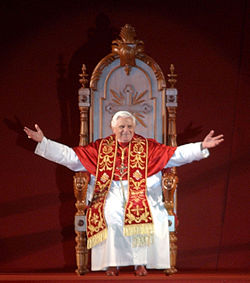
During his reign, Pope Benedict XVI made 30 pastoral visits within Italy and 25 foreign trips, visited 25 countries. His most visited countries (outside of Italy) were Spain and his native Germany with three visits each. With an average of three foreign journeys per year from 2006 to 2009, he was as active in visiting other countries as his predecessor, John Paul II, was at the same age from 1999 to 2002. Pope Benedict was more active since then, however, making five foreign journeys each in both 2010 and 2011, significantly more than the six total trips made by Pope John Paul II at the same age in 2003 and 2004. As of the 2012 apostolic journey to Mexico and Cuba, Pope Benedict XVI was older than Pope John Paul II was at the time of his death, [1] as well as being the oldest Pope to travel to Africa, Asia (including the Middle East), and Australia. [2] [3]
Contents
- Journeys outside Italy
- 2005
- 2006
- 2007
- 2008
- 2009
- 2010
- 2011
- 2012
- Journeys in Italy
- 2005 2
- 2006 2
- 2007 2
- 2008 2
- 2009 2
- 2010 2
- 2011 2
- 2012 2
- Previously confirmed journeys
- See also
- References
- External links
Most of these trips involved the Pope giving speeches on issues that play an important role in the region that he visited, especially on education, contraceptives, abortion, and what it means to be Catholic.





